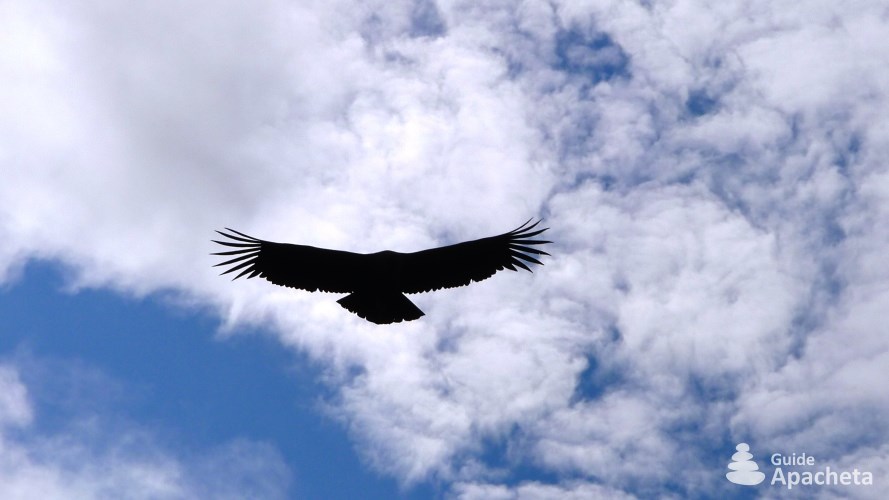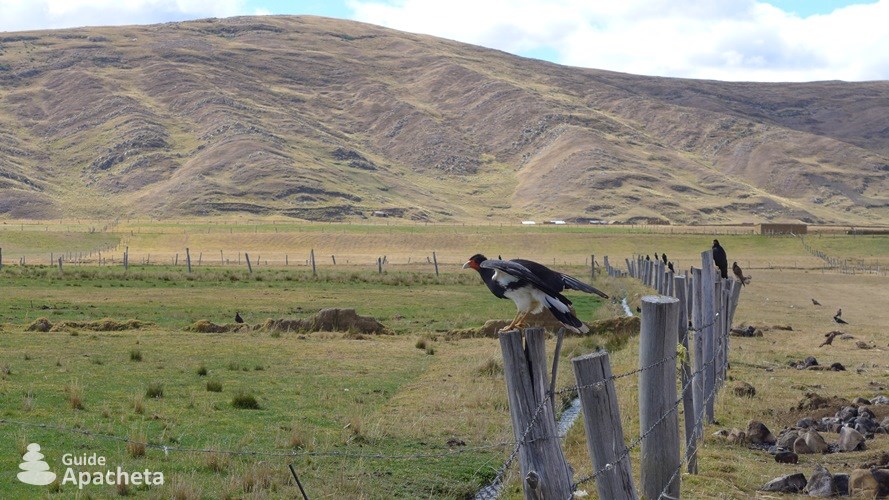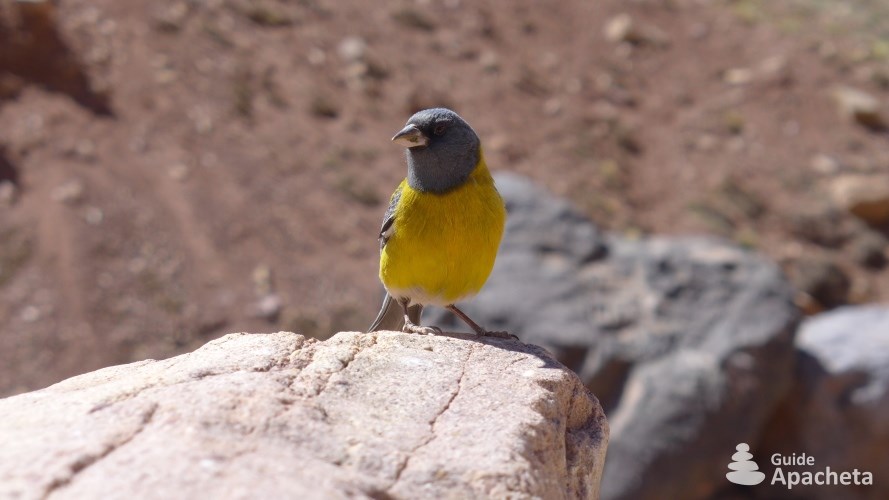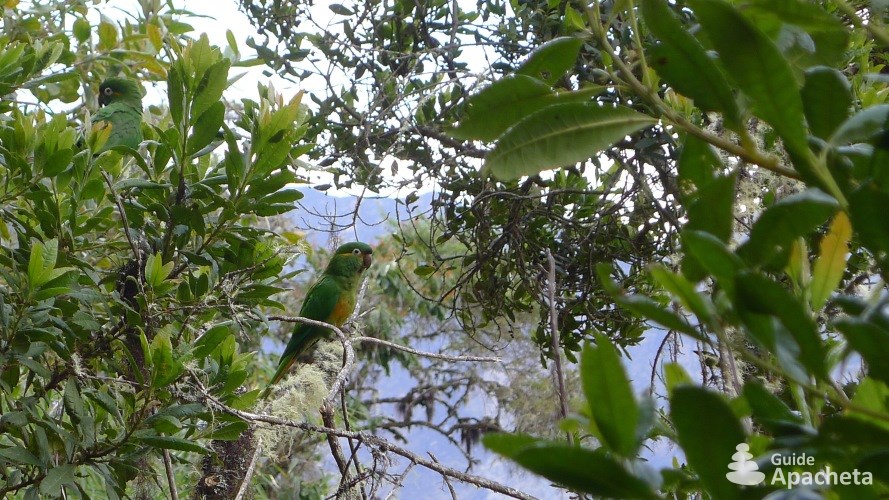Andean birds of Peru
Peru benefits from an exceptional fauna which is due to its very diversified environment between the coast, the sierra (Andes Cordillera) and the selva (Amazonian jungle). In the Andean region, the fauna varies according to the different ecosystems:
- Rain forest
- Dry forest
- Puna
- Cultural landscape
Below are the most frequent and representative species of the Peruvian Andes. For the mammals, please refer to the article Andean fauna of Peru.

List of Andean birds in Peru
Great horned owl (Bubo virginianus) – see picture
Local name: Búho americano
This bird lives on the American continent, from Alaska to Tierra del Fuego, at altitudes between 0 and 4400 m, in all types of landscapes (dense forests, desert, plains, cliffs, urban parks, rocky canyons). Rather sedentary in nature, this bird sometimes migrates southwards. The same pair can keep its territory for 8 consecutive years. With its characteristic egrets, it is the largest nocturnal raptor in America. However, its size varies from 90 to 160 cm depending on its habitat and the abundance of its food. Its head and face resemble that of a cat because of the ears, eyes and the shape of the head. Its flight is fast and graceful, and it flies noiselessly.
Active at dusk and during the night, it has a binocular vision one hundred times more developed than human vision. It can hunt animal prey 2 to 3 times heavier than itself and is one of the birds that regurgitates balls of bone, hair and feathers.
Chilean flamingo (Phoenicopterus chilensis) – see picture
Local name: Flamenco chileno
The most widespread of the flamingos in South America, this species is found in the Andean mountains of Peru, Chile, Argentina and Bolivia, all the way to Tierra del Fuego. It lives close to marine coasts, salt and freshwater lakes, from sea level to an altitude of over 4500 m. A migratory bird, this bird is as good in flight as it is in swimming. It feeds on crustaceans, which give it its pinkish colour, as well as aquatic plants, algae or small animals living in the mud.
Its pale pinkish white plumage, pinkish wings with black tips and greyish yellowish legs differentiate it from the flamingo. Highly sociable, pink flamingos live in groups ranging from several dozen individuals to a few thousand birds. Because of the inhospitable places where they live, flamingos have few predators.
Junin grebe (Podiceps taczanowskii) – see picture
Local name: Zambullidor de Junín
This bird, which exclusively inhabits Lake Junin at 4080 m above sea level (or lago chinchaycocha in Quechua) has been designated a regional bird and a symbol of conservation. Its distinction is quickly seen thanks to its red eyes and its opaque brown ear feathers.
It is easy to observe as it is not used to taking refuge in the vegetation.
Its main characteristic comes from its inability to fly, its pectoral muscles being poorly developed.
There are only 217 of them registered in the Junin National Reserve, for this reason this species is classified as being in great danger of extinction. Contamination of the water by mimes in the surrounding area is the main cause.

Andean goose (Chloephaga melanoptera) – see picture
Local name: Cauquén huallata
This rather heavy goose cannot be confused because of its very small beak and white plumage (except for the blackish hindquarters).
Quite common, it has been found on the high plateaus of the Andes, above 3000m, from central Peru to central Argentina, on humid ground. The Andean goose lives in pairs or with its family on the edge of high altitude lakes or marshes. In winter, they descend into the plains and valleys to shelter from the harsh weather conditions.
Torrent duck (Merganetta armata) – see picture
Local name: Pato de torrente
Widespread and sedentary, the merganette is present in almost all the Andes mountain range. It frequents torrents with emerged rocks, rapids and waterfalls. It is generally found between 1500 m and 3500 m above sea level. Like the Andean Goose, it descends into the valleys in winter but never below 1000m (except in Chile).
The male and female have a very different plumage. The males have in common their black head striped with white, while the females have a finely vermiculated grey on top to a bright reddish-brown underneath at the neck and throat. An excellent swimmer, the Merganette does not hesitate to dive into the most impetuous rapids in search of insect larvae, molluscs and other creatures that make up its menu.
Puna ibis (Plegadis ridgwayi) – see picture
Local name: Ibis de la Puna
A close relative of the Falcinella Ibis (which lives in Europe and North America), this bird is distinguished by the red colour of its beak.
Not very common, it can be seen near marshes, lakes or flooded fields in the Andes, sometimes on the coast or in the Amazon. To feed, it hunts with an enhanced sense of touch, probing the ground for crustaceans or worms.
Andean lapwing (Vanellus resplendens) – see picture
Local name: Avefría andina
This bird is commonly found in the vicinity of herbaceous marshes, lakes and cultivated fields, between 2000m and 3000m altitude. It is used to live in pairs and rarely travels alone. With a nervous temperament, this bird carefully observes its environment to detect the presence of danger.
Its pink legs and yellow and black beak make it easy to distinguish it from other birds.
The Andean Lapwing feeds on crustaceans, aquatic insect larvae and occasionally fruits and seeds.
Andean gull (Chroicocephalus serranus) – see picture
Local name: Gaviota andina
It is the only seagull that can be seen in the sierra (mountainous area). This species lives near lakes and rivers, between 3000 and 4500 m above sea level. It nests in isolated and scattered colonies.
During the breeding season, the adult male has a black hood in the shape of a half-moon at eye level, the rest of the body is white. Its legs and beak are dark red in colour.
Andean condor (Vultur gryphus) – see picture
Local name: Cóndor andino
This bird of prey is a national symbol, inseparable from the ancestral Andean peoples and plays an important role in the folklore and mythology of the Cordillera countries. Its habitat is located in the Andes, between 3000m and 5000m above sea level, as well as along the Pacific coast. With a wingspan of up to 3.20m, it is the largest flying land bird in the Western Hemisphere.
This vulture can be distinguished by its large collar of white feathers around its neck. The male bears a large crest on the top of his head. Unlike most birds of prey, the male is larger than the female.
Condors are sociable and live in groups, led by a dominant male.
Essentially a scavenger, it feeds on large carcasses of various species.
It is one of the longest living birds in the world, with a lifespan of up to 50 years, but its population is in constant decline (loss of habitat, poisoned food). Since 1977, it has been registered in the list of endangered species.

Mountain caracara (Phalcoboenus megalopterus) – see picture
Local name: Caracara cordilerano
With various names, this bird of the falcon family lives in the Andean altiplano, between 3000m and 5000m above sea level, at a distance from abundant vegetation. It nests in steep rocks. Its food consists of small mammals, birds and insects.
The mountain caracara lives alone or in pairs, rarely in groups. Although sedentary, it can travel great distances after the nesting period, which takes place between October and December. Lonely and shy by nature, the Mountain Caracara keeps its distance from human presence.
Variable hawk (Buteo polyosoma) – see picture
Local name: Aguilucho variable
A polymorphic species, it has at least 2 colour phases, with light phases predominating over dark phases. The grey mantle always indicates the male while the red mantle usually indicates the female.
Quite common, the tricolour hawk frequents variable locations, such as temperate Andean valleys, arid tropical plains and hills along the Pacific coast, scrubby areas or the edges of cultivated slopes. They can live up to 4600m above sea level but are most frequently visible between 1600m and 3200m.
This migratory buzzard often hunts in the air, allowing itself to be carried by currents or hovering in search of the mammals that make up the bulk of its food.
Black-chested buzzard-eagle (Geranoaetus melanoleucus) – see picture
Local name: Aguilucho pechinegro
This large bird of prey has all the characteristics of an eagle, except for the shape of its beak. The male and female are identical, with a slightly larger female.
Its striped plumage, combined with its particular morphology make it fairly easy to identify. Western hawks aguia inhabit the steep rocky mountains and steep slopes interrupted by canyons, from sea level to 3500m altitude, except in the northern Andes where they do not descend below 1600m.
Usually solitary (or in pairs) and sedentary, the buzzard may gather from 3 to 5 individuals, presumably family groups. It mainly consumes mammals, wounded birds, snakes, lizards, carrion and insects and seeks their food in circular flight or by making long diagonals letting itself be carried by the wind before diving. The population is quite present in suitable habitats, where it is easy to observe them.
American kestrel (Falco sparverius) – see picture
Local name: Cernicalo americano
The smallest hawk in America, this kestrel is approximately the size of a large thrush. The sexes are dimorphic and can be distinguished by their plumage, with the male wearing spots on his lower abdomen and thighs, and the female having narrow black stripes across her legs.
Widespread throughout most of South America, this species is found in open areas with a few scattered trees, forest edges, farms, city outskirts and parks in urban areas. High perches and open spaces, necessary to satisfy their hunting requirements, influence the choice of sites. Their diet consists of insects, mice, lizards, shrews and small birds.
Cavernicole, this kestrel nests in all sorts of cavities: tree hollows, rocky cavities, crevices, cliffs, nesting boxes… This dominant bird has no trouble dislodging other cavernicole species or mammals (squirrels, chipmunks)!
Giant hummingbird (Patagona gigas) – see picture
Local name: Colibrí gigante
The giant hummingbird is a species of Andean hummingbird, the largest in its category.
Its presence is linked to the flowering period of the plants it feeds on, for example at the beginning of the rainy season (December, January, February) in the southern Andes of Peru (Ayacucho) when the puyas (a species endemic to the high Andes of Bolivia and Peru) flower.
It is common in the western slope of the Andes and in the inter-Andean valleys.
It is the size of a swift and can be confused with the latter. It flies on the spot like other butterflies, but the beats of its wings are slower (8 to 10 beats per second) and are reminiscent of those of a butterfly. There are about 100 species of hummingbirds in Peru and 300 in America, although these birds are only found in the United States.
Peruvian sierra finch (Phrygilus punensis) – see picture
Local name: Fringilo peruano
It is an endemic Peruvian passerine bird that lives in the Andean areas, close to gardens, houses and cultivated fields, at an altitude of between 2500 m and 4500 m. It looks for food, mainly seeds, on the ground and in the trees. The female is similar to the male, with bluish tones on the head and wings and yellow on the rest of the body, although the colour is slightly paler.
Rufous-collared sparrow (Zonotrichia capensis) – see picture
Local name: Gorrion de collar rufo
Very common, it is found in almost all of South America, from the coast to the Andes, through the Inter-Andean valleys and the Amazon. It is characterised by its grey cap with black stripes and its red neck.
The bunting can be seen alone or in groups. It feeds on seeds, insects and spiders, close to the ground, in bushes, hedges and cultivated areas. Well known for its voice, it emits typical and regular sounds.

Black-faced (Theristicus melanopis branickii) – see picture
Local name: Bandurria andina
A fairly rare Ibis found in high habitats between 3000m and 5000m above sea level, on the edge of open pastures, and often near cliffs and ravines where it nests in colonies. In unfavourable times, it can make short migrations to lower altitudes. This subspecies of the altiplano has a shorter bill than the others.
Andean flicker (Colaptes rupicola) – see picture
Local name: Carpintero andino
This thick-bodied bird has a broad, sharp beak. It is found in the Andean areas between 3500 m and 5000 m above sea level. It nests in rocky hollows, abandoned buildings or in holes dug in the ground.
It feeds on the ground, walking (but not hopping). In Andean cultures, this bird, which is quite rare, is caught and cooked for its feathers and meat, as these are said to have beneficial effects on the production of mother’s milk.
Mitred parakeet (Psittacara mitratus) – see picture
Cotorra mitrada
Present from Peru to Argentina, the mitred horn is distinguished by its scarlet forehead.
Its habitat is located on the eastern slope of the Andes and in the inter-Andean valleys, near humid woods, between 1000 and 3500 m above sea level.
Generally in small bands, it can gather up to a hundred individuals during the breeding and nesting periods. This bird feeds on seeds and fruits.
Discover the guidebook of Vilcabamba Mountains in Peru.
